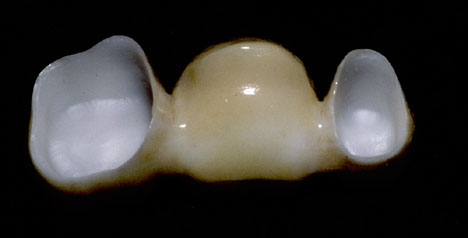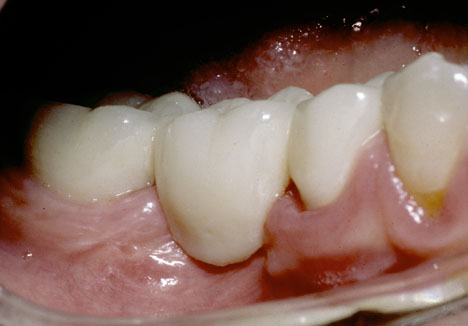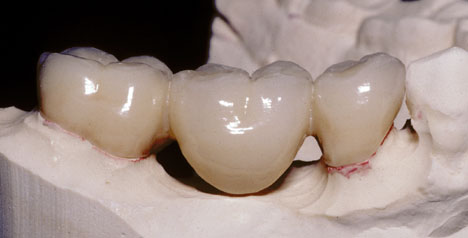Wolfgang Schaal
One of the most difficult areas in dentistry today is the restoration of dental structures with biocompatible materials that are strong enough to withstand the forces of chewing (500-1000lbs pressure on molar teeth). Recent technology from Germany now offers a material that has overcome most of the pitfalls of present day products. Patients now have a choice of a material that is esthetic, strong, pure, biocompatible and capable of being used for single and long span dental bridgework. That material is called Zirconium oxide.
Zirconium oxide has the following superior characteristics that make it the most ideal material available:
- Excellent biological compatibility: absolutely bio-inert.
- Outstanding physical and mechanical qualities:
- Hardness (Vickers) 1200 HV
- Compressive Strength 2000 MPa
- Bending Strength 1000 MPa
- Modulus of Elasticity 210 GPa
- Tensile Strength 7 Mpavm
- Wear characteristics (Ring on disc) <0.002 mm 3/h
- Absolute corrosion resistance: Ringer’s solution 370C <0.01mg/m2x24h
- Very small particle size: <0.6ym
- No glass phase for particle binding
- Extremely high density
- Porosity: 0%
- Purity (Zr/Hf/Y): 99.9%
- Translucence of the framework material makes excellent cosmetic results possible
- Equivalent fit to precision gold castings: edge opening 20-50 ym. Precludes the need to use adhesive cements.
- Zirconium oxide is manufactured and optimized industrially so that the material qualities remain unchanged through the complete production chain.
- Optimal material for crowns: tasteless, radiopaque, no pulp irritation because there is no need to use adhesive cements and minimal invasive preparation by dentist.



Photos courtesy of Dr. Gerald H. Smith
Zirconium oxide forms the core of each crown and provides the cross-link that bridges the gap of missing teeth. The precision fit of the Zirconium core is derived from computer guided Swiss lathes that cut the form out of a solid Zirconium oxide block. The cutting instructions are obtained from a laser beam that reads 120 points per millimeter from the anatomy of a model of the prepared teeth. Once formed, new synthetic porcelain (99.9% pure) is baked on to the Zirconium core and then shaped like a tooth. Because of the extreme accuracy of the crown fit, the crowns can be cemented with biocompatible dental luting material. This avoids the use of an invasive procedure of etching the tooth with acid and injuring the pulp or nerve of the tooth. This latter procedure often times results in the pulp dying and necessitating root canal therapy.
Advantages of ET zirconium high performance ceramic compared with other full ceramics
Zirconium oxide ceramic primarily stands out due to its high crack resistance. Crack resistance is the resistance with which the material counteracts the spreading of cracks. If a material is stressed, it usually comes to excessively high tension within a defect area (pores, surface deficiencies, cavities) or it cracks. While with metals under high tension in the area of cracks, plastic deformation appears and the top of the tension can be reduced by rounding the cracks; in ceramics due to missing plastic deformation possibility the cracks continue to grow. The unusual feature of zirconium oxide ceramic in comparison with other ceramics is that at the appearance of a high-tension area a transformation of the crystal structure can take place. This process is also accompanied by a volume expansion. By this volume increase it builds wedges in the crack and therefore it reduces the continuation of the crack. While the critical tensile strength (KIC) e.g. of Dicor, Vita Mark II and Empress is in the area of 1-2.5 Mpam-1/2, zirconium oxide shows values in the range of 10 Mpam-1/2. Even In-Ceram (glass infiltrated Al203 ceramic) and Procera aluminum oxide (pure Al203 ceramic) show values less then 5 Mpam-1/2.
In connection with the tensile strength there also stands the characteristic of bending strengths. While conventional glass ceramics show results of 100-200 Mpa and aluminum oxide ceramics lie in the area of 400-600 Mpa, zirconium oxide reaches a bending strength of over 1000 Mpa.
Because of the high tensile strengths exhibited in test results, it is now possible to fabricate posterior bridges with zirconium oxide. Further decisive advantages of zirconium oxide are its high resistance to corrosion; stability to hydrolysis and its high biocompatibility in comparison with other ceramics makes this material ideal for restorative dentistry.
In medicine, zirconium oxide is being used more and more as the material of choice especially for hip prosthesis. For years there has existed substantial clinical tests and examinations which confirm the high quality of zirconium oxide.
Further research sources on zirconium oxide:
Paul Scherrer Institut 1986 and 1987
Ludwig Maximilian Universitat Miinchen (E. Fischer-Brandis)
Institut fur Strahlenschutz,
GSF-Forschungszentrum fur Umwelt und Gesundheit, Neuenburg (R. Winkler)
Strahlenbiologisches Institut der Universitift Munchen (H. Roos)
In addition, zirconium oxide has been accepted by the Food and Drug Administration, Washington (FDA) and the Minist’ ere de la Sante’, Paris.
Schaal Dental Laboratory
Alpenveilchenstra Be 39
Munich, Germany 80689
Fax 011. 49. 89 7400.7420

